I Dig Sports
Rohit Sharma: 'There is no role for an anchor in T20 cricket now'
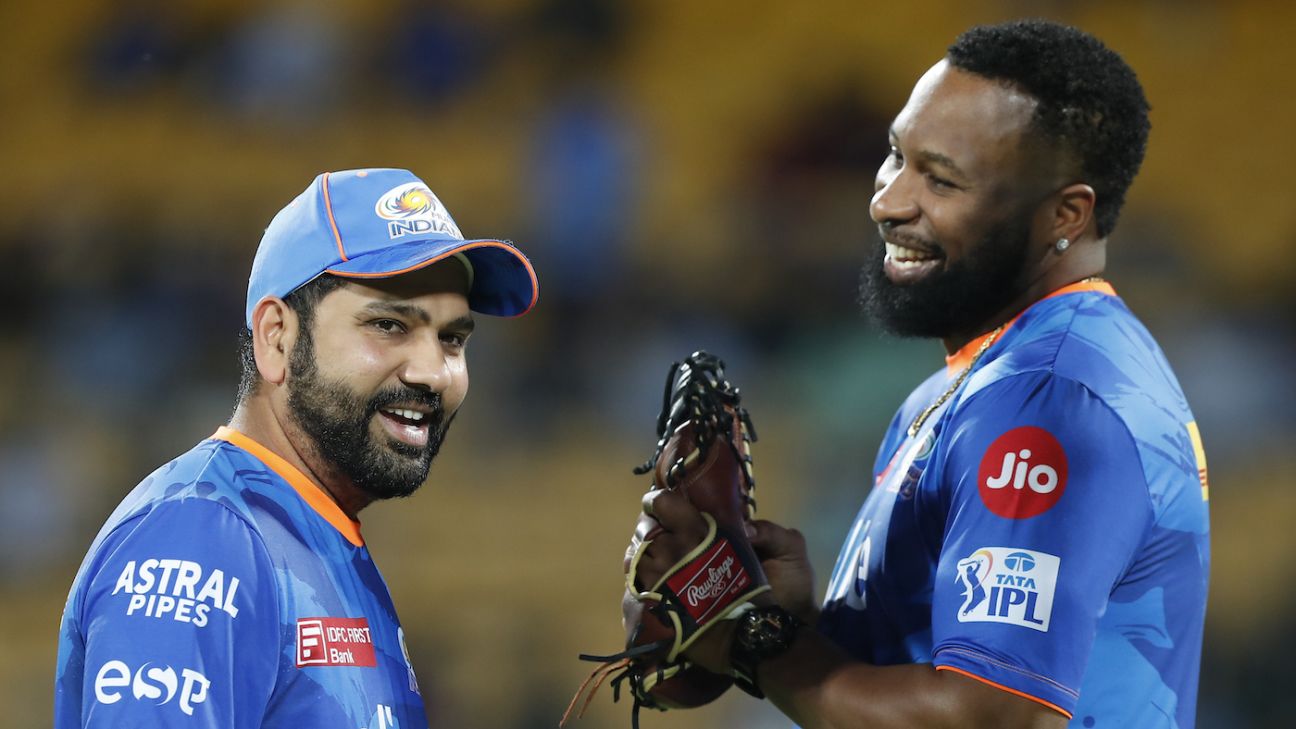
"As I see it, there is no role for an anchor now. It is just how T20 cricket is played these days, unless you are 20 for 3 or 4, which is not going to happen every day," Rohit said. "Once in a while, you will be in that position and then someone needs to anchor the innings and finish off to a good score. [But] there is no role for an anchor anymore, guys are playing differently."
Rohit said he felt a change in mindset is mandatory. "If you do not change your mindset, you are going to get smashed," he said in a conversation with Jio Cinema. "People on the other side are thinking about the game differently and taking it to the next level.
"All seven batters need to play their role, I believe that if you get a good score, it is good, but even if you get a good 30-40 off just 10-15 or 20 balls, it is as good because you are doing the role for the team. The game has changed."
Rohit said he has played T20 cricket long enough for him to try new things without worrying about a failure. "I just want to play that way and see what I can do. I have played this format for a long time and in a certain manner. But I want to do different things now. While doing that, [if] I get out, [it] does not really bother me.
But, he said, he cannot switch to all-out power-hitting because others are doing so, and would prefer to get the runs in his own way.
"But my thinking is that if I am getting a six after 65-70 metres, I only have to hit 80 metres. Why do I need to hit 100 metres? I will do that once you allow eight runs for it.
"I will hit 80 metres only because I am getting six runs for it, and for that I need to time the ball. I do not need to muscle the ball like the other guys do - that is their strength. My strength is to get the ball in the middle of the bat, which is what we call the sweet spot."
Tilak Varma and Nehal Wadhera will be huge stars, says Rohit
Rohit, who's Mumbai team is looking for their sixth IPL title, said they are tagged a team of superstars, but the franchise has had to work for this to come about.
"Yes, it is a superstar team, but it is because the franchise has worked for it. All these players are part of the big auction pool - we have bought them.
"It is going to be the same story with what has happened with Bumrah, Hardik and all these guys. Tilak Varma and Nehal Wadhera... you watch the next two years. But then people will say 'it is a superstar team'. Yes it is, we are making them here. These two guys are going to be huge stars for us and for India."
Edited PTI copy
McCullar returning to Kansas after exiting draft
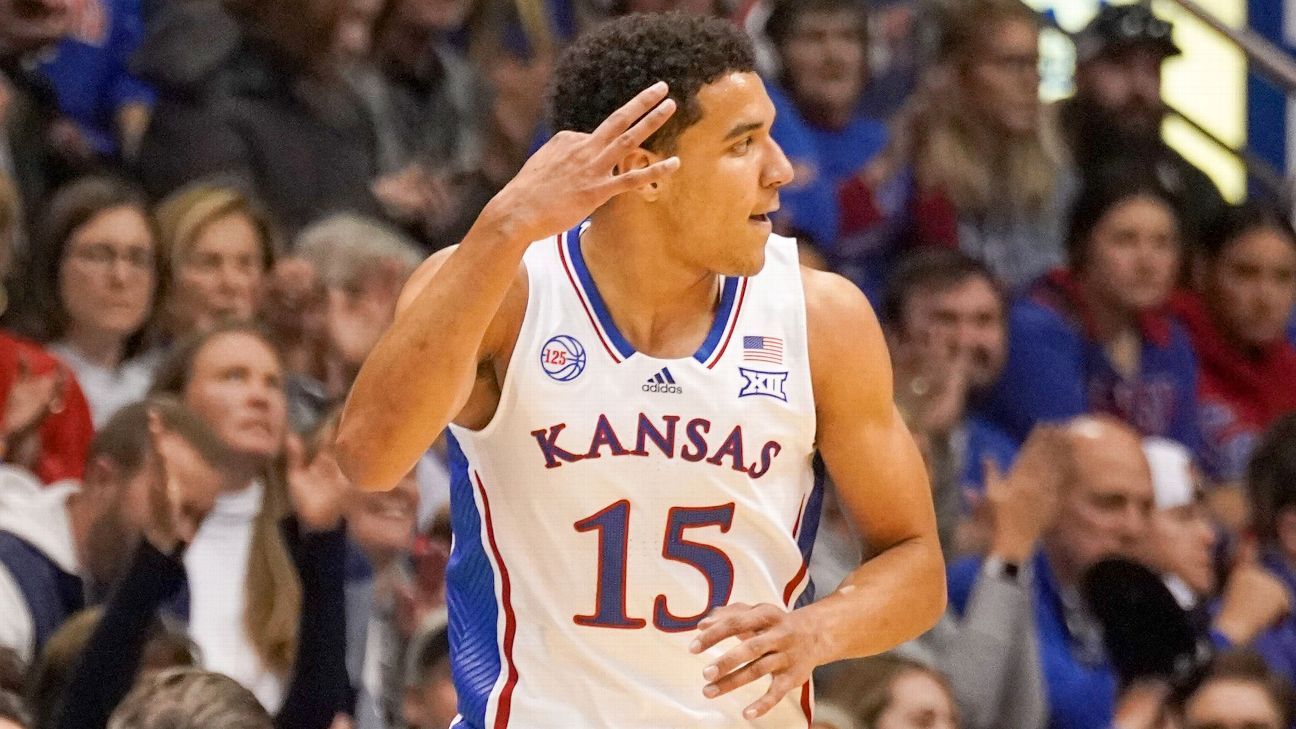
Kansas forward Kevin McCullar Jr. has withdrawn his name from the NBA draft and will return to the Jayhawks for his final season, the school announced on Wednesday, likely cementing Kansas as the preseason No. 1 in men's college basketball.
McCullar attended the NBA draft combine, but was not a lock to be selected; ESPN had him No. 70 in its draft rankings. For Kansas, however, his return gives Bill Self's team one of the best defenders in the country as well as experience and continuity.
"How about one more year Jayhawk nation," McCullar said. "To be able to play in front of the best fans in the country; to play for the best coach in the nation, I truly believe we have the pieces to hang another banner in the Phog. Rock Chalk! Let's do it!"
A 6-foot-6 wing from Texas, McCullar started 33 games last season for Kansas, averaging 10.7 points, 7.0 rebounds, 2.4 assists and 2.0 steals. It was his first season in Lawrence after spending the first three seasons of his career at Big 12 rival Texas Tech. McCullar earned third-team All-Big 12 honors last season and was named honorable mention all-league in 2021 and 2022.
He's also one of the elite defenders in college basketball, being named a Naismith Defensive Player of the Year semifinalist each of the past two seasons.
"This is a big day for Kansas basketball," Self said. "We've had a lot of good things happen through recruiting this offseason, but nothing that has transpired this offseason was bigger for KU basketball than having a seasoned veteran like Kevin McCullar return to our program."
With McCullar back in the fold, Kansas has a strong chance to be the No. 1 team entering next season. The Jayhawks rose to No. 2 in ESPN's Way-Too-Early Top 25 after the addition of Michigan transfer Hunter Dickinson, the best player in the portal, but McCullar puts them over the top. He joins Dajuan Harris and K.J. Adams as returning starters from last season's Big 12 champions, while Dickinson, Arterio Morris (Texas) and Nicolas Timberlake (Towson) should all be impact transfers. Kansas also adds a top-15 recruiting class, led by No. 25 overall recruit Elmarko Jackson.
Commanders TE Rogers suffers Achilles injury
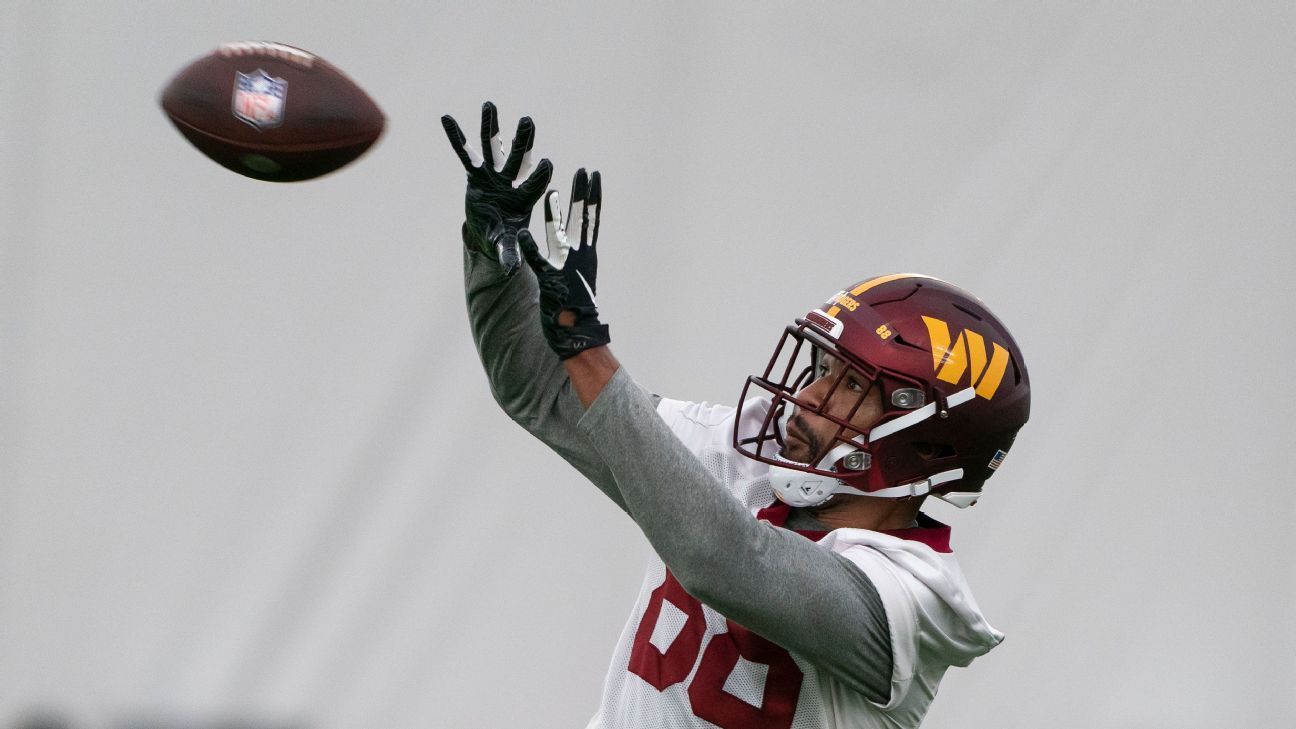
ASHBURN, Va., -- Second-year Washington Commanders tight end Armani Rogers, whom the team anticipated becoming a bigger part of its offense this season, suffered a noncontact Achilles injury and likely is lost for the season.
Rogers suffered the injury while running during an OTA practice Tuesday.
In 11 games, three of them starts, Rogers caught only five passes for 64 yards last season, but he missed time with various knee and ankle injuries. He had transitioned from being a college quarterback with Nevada and then Ohio University to an undrafted free agent NFL tight end.
His progress, as a blocker and as a pass-catcher, pleased Washington. The Commanders liked his athleticism.
"It's a blow," coach Ron Rivera said. "The young man really progressed well for us last year. But we feel confident in the group of tight ends."
Washington still has veterans Logan Thomas and John Bates, as well as 2022 fifth-round pick Cole Turner and an undrafted free agent last year in Curtis Hodges.
Au revoir, Paris: What Victor Wembanyama is leaving behind for the NBA
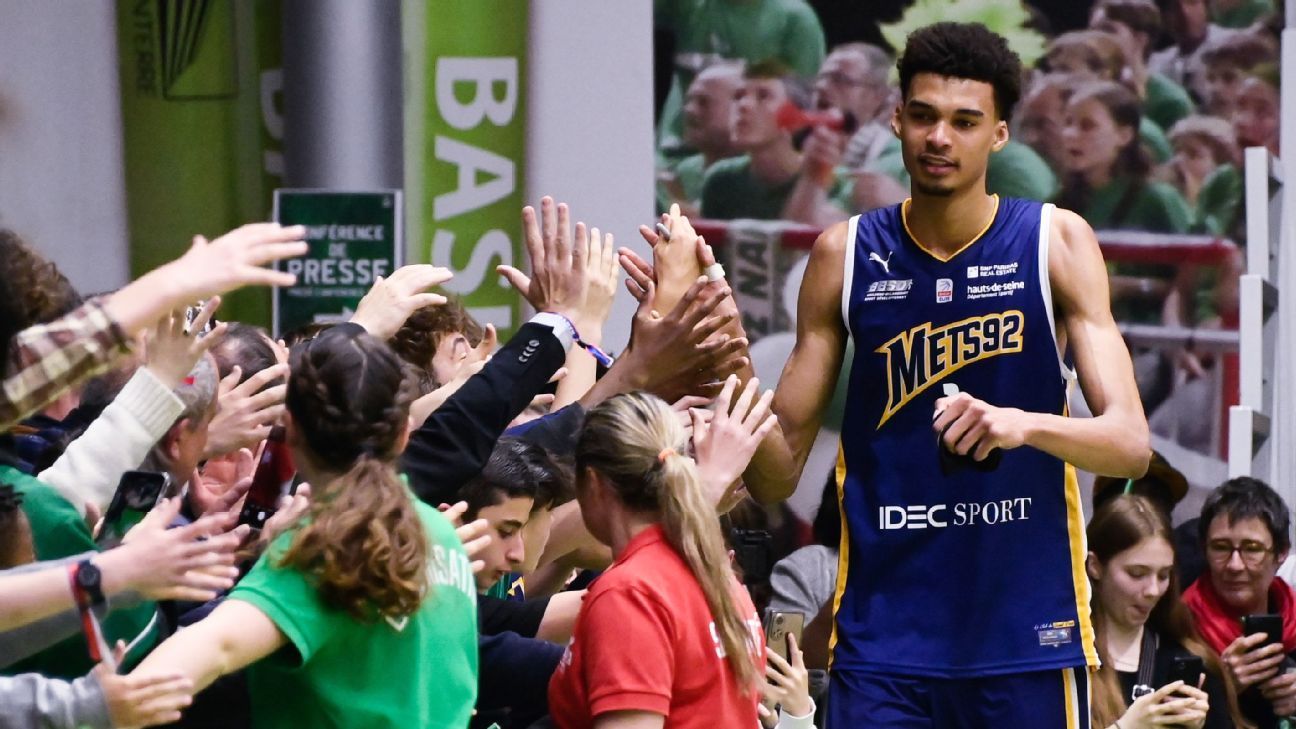
Victor Wembanyama runs toward the bleachers. His team has just won its latest French league game in the Paris suburbs, but as his teammates fist-bump one another and amble in the direction of the locker room, Wembanyama goes the other way. He literally sprints toward the stands.
When he arrives in front of the hundred or so most passionate supporters of Nanterre (who, to be clear, root for the team Wembanyama has just beaten), the gangly, 7-foot-4 teenager doesn't preen in front of them or woof about having put up 25 points, 17 rebounds and 4 blocks. He doesn't wave his arms or sneer. He doesn't do, really, any of the things that young (and not so young) athletes do when they're looking to strut a little.
Instead, Wembanyama bows his head. He tilts his body forward. He drops his shoulders.
He leans into the crowd of people and lets them wrap him in a group hug.
Over the next few weeks and months, Wembanyama's life is going to be unceasingly about what comes next: How he handles (almost surely) being drafted by the San Antonio Spurs. What his transition to the NBA is like. Where he ends up standing in relation to great French players, like Tony Parker, and just greats, like LeBron James.
It will be relentless, and there are few weights quite so heavy as that of the future laying on the back of a young person's neck. Wembanyama has no illusions: He knows what lies ahead.
But he also knows there needs to be a goodbye.
Long before the word "Wemby" was part of the global basketball zeitgeist, Wembanyama was a big kid from a small village who made good. A kid who was proud to be French, who was determined to rise up through the French sports system, who has a connection to places and people and memories in France that are -- NBA or not -- very hard to leave.
That is why, on this Tuesday night in Nanterre, Wembanyama's eyes are wet when he finally emerges from the mass of fans. Nanterre, despite being dominated by Wembanyama on this particular evening, will always be the club where he played as a boy, the club that made him. It will always feel like a home. And this is a farewell.
Wembanyama steps back and waves. He makes the shape of a heart with his hands. He smiles and nods as the fans begin to chant, "Il est d'ici! Il est d'ici!"
He's from here, they say over and over. He's from here.
TWO DAYS BEFORE the game in Nanterre's tiny gymnasium, Wembanyama plays the Accor Arena, Paris' biggest indoor venue. Wembanyama's team, Metropolitans 92, known colloquially as the Mets, typically hold their home games in a small arena in Levallois-Perret, on the outskirts of the city. A full crowd there might be 2,800. This game has been moved, though, to give more people the opportunity to see Wembanyama up close before he leaves.
Nearly 16,000 fans jam inside. Tickets sell on the secondary market for several hundred dollars. Some things about the atmosphere -- like the depths to which otherwise-normal people will debase themselves to get a T-shirt shot at them from an oversized gun -- are the same as on a random night anywhere in professional sports. Other aspects, like the singular focus on Wembanyama (Wemby running, Wemby stealing, Wemby blocking, Wemby dunking), feel unique.
The crowd erupts when Wembanyama steals the ball in the first quarter and goes coast-to-coast for a dunk. The crowd erupts when Wembanyama makes an authoritative block. The crowd erupts -- in anger -- when Wembanyama is called for a questionable offensive foul and then gestures at the fans, encouraging them to boo the referee even more.
"I'm here for Victor," says Paulo Lopes, who is wearing a Wembanyama jersey and buying a soda on the concourse.
"I'm here to see Victor," says Sylvain Mousseau, who is sitting in the upper deck with his family.
"I'm here because my son told me we have to see Victor," says Anne-gael Salaun, whose 8-year-old, Carl, has already begun negotiating screen time rules with his mother so he can watch Wembanyama's NBA games next season.
It doesn't matter that many (if not most) of the people at the game are not regular followers of French basketball. The vast majority of people at the Louvre on any given day aren't art connoisseurs; they just want to see the Mona Lisa, to see something truly beautiful with their own eyes.
It is the same with Wembanyama, a giant who plays like a guard. He is angular and spindly, but also powerful and fierce when he gets near the basket. His ability to shoot from distance is that of a man half his height. He is the kind of player who can (and does) win the French league's MVP, best young player, best defender, best shot-blocker and top scorer awards all in the same season. LeBron James called Wembanyama a basketball alien. And who doesn't want to see such an extraordinary player?
"I felt so much emotion seeing the number of people who had come," Wembanyama says. "I sometimes see dads or moms who absolutely want a photo [with me], not even for their children. Just for them. It's funny and it's fun."
Understanding what Wembanyama means in the context of French culture is tricky. Basketball is still something of a niche sport in France, at least in comparison to soccer, and Wembanyama plays in a region that features Lionel Messi and Kylian Mbappé as sporting contemporaries, not to mention a slew of other incredible art and film and culinary cultural touchstones.
Yet there is something about Wembanyama that is captivating. Part of it is simply the moment -- Wembanyama is big around the world, so he is big in France -- but Pascal Giberné, a French writer and broadcaster, says there is also something about the way Wembanyama carries himself that resonates deeply with French people.
Wembanyama's lack of interest, at least so far, in publicizing himself or making himself into anything beyond a talented young basketball player has given him an ethereal, almost mythical quality in France.
"Usually French people don't like it when you are too confident -- we don't have here what you'd call 'cockiness' in the United States; it's just arrogance," Giberné says. "Victor isn't any of this. People are just captivated by him. He is cultivating this mystique and people are more attracted by this.
"They are proud that he is French, because he is proud that he is French and he acts that way," Giberné says.
There is also a theory being bandied about among sports journalists and fans that Wembanyama could be the face of a larger shift toward basketball in France. The sport's popularity has surged with younger fans around the world over the past decade, and if Tony Parker and Boris Diaw were among the initial generation of French stars to inspire interest in basketball in France, then Wembanyama -- if he really does reach the heights that have been speculated -- could push the swing even farther.
Maxime Raynaud, who played with Wembanyama in Nanterre's youth system and is now a sophomore at Stanford, says the timing for this turn is ideal.
"We've had this traditional setup in France -- you are going to play the sport your dad played, or the sport he watches," Raynaud says. "And so for the past 100 years, everyone just picked up a soccer ball. Now, we have access to basketball. We have role models for basketball. And Victor is going to be the face of that.
"Some people might be sad that Victor is leaving France," Raynaud continues. "But I think most people, especially young people, are happy that he is going to the United States -- to show the strength of what can come from France."
FOR THE LAST YEAR, Wembanyama has lived on Ile de la Jatte, a long, skinny island in the River Seine to the west of Paris. In addition to being picturesque and private (Nicolas Sarkozy, the former president of France, is among its past and current residents), Ile de la Jatte is removed, both literally and figuratively, from the thrum of the city.
Wembanyama's connection to France isn't through the Eiffel Tower or the Arc de Triomphe, in the same way no New Yorker's bond with their city has anything to do with the Empire State Building. It is the people -- the neighbors, the shop owners, the regulars in a person's life -- that stick.
Over the footbridge connecting Ile de la Jatte to the commune of Neuilly is Wembanyama's regular market where Rose, the woman who works there, knows to take out mangos and grapes and clementines when she sees Wembanyama approaching ("I always put the best mangos up front," she says). A few doors up is the grocer where Max, the man who stocks the shelves and worries about Wembanyama hitting his head on the pendant lights that hang above the aisles. On the corner is the butcher, where Wembanyama -- who has always been interested in cuisine -- will stop for a roast chicken and potatoes, and chatter with Imad or Nicolas in their aprons, or Brigitte behind the register, about how much fat went into their preparation or what type of heat they used to cook the meat.
"I think the notion of family has always been really important to Victor," Raynaud says. "And that doesn't just mean his biological family. It's everyone in his life. He has this feeling for them that is very strong and he will not hide it."
Wembanyama has always been this way. There is a softness to him, a candor and earnestness that makes it impossible for those around him not to feel kinship. Amine El Hajraoui, a longtime administrator and youth coach at Nanterre, recalls a weekend tournament years ago when Wembanyama, no more than 13, showed up for a morning game carrying a plastic bag full of precooked, vacuum-sealed drumsticks. Wembanyama, who was already well over 6 feet tall, did not understand why everyone was looking at him quizzically. "What?" he said sincerely. "I need these. I'm still growing!"
El Hajraoui remembers the chicken, but also the conversations they would have about life and family and the TV show "Rick & Morty." ("He loved that show," El Hajraoui says.) Bryan George, who coached at Nanterre, remembers playing board games with Wembanyama -- on the bus, in the dorms, wherever. They both loved Risk, a game which was originally invented in France.
Raynaud thinks of Wembanyama at Big Time, the fast-food restaurant in Place de la Boulle, a short walk from the dorms, where Nanterre players would go after big wins. Or Wembanyama reading books in the extra-long bed the club had specially made for him. Or Wembanyama talking about manga. Or Wembanyama showing him, every once in a while, the sketchbook where he does his own drawings.
"My best memories of basketball are in these places," Raynaud says. "We were just there, together. We were ourselves. However big a player he was, Victor was always just himself."
Nanterre officials have put nameplates above dorm rooms where certain players stayed to commemorate what they accomplished. Typically, those nameplates go up many years after the athlete is gone -- once they've had an impressive career or succeeded with the national team.
Wembanyama left Nanterre in 2021. There is already a nameplate above his old room.
"Victor is special," El Hajraoui says. "Anyone who stays here now can feel his aura."
WHEN WEMBANYAMA WAS 14, he spent a summer playing with Barcelona's basketball club. The Spanish team was interested in bringing him to their program full time, and the offer was intriguing: Barcelona is a much bigger club than Nanterre. A bigger city. A bigger stage.
Wembanyama said no. As appealing as it was to have Barcelona try to woo him, Wembanyama was concerned that Barcelona's coaches wouldn't be critical enough. Wouldn't push him hard enough to make every facet of his game be the best.
In Nanterre -- with the French coaches he trusted and the life he knew -- he felt safe, even if it would be harder. It was better for him to stay in France, he thought.
"He wasn't trying to be something he wasn't," Raynaud says. "He didn't want to go to Spain. He didn't want to move around. He is a French guy. He's French. It's clear."
Back then, the time wasn't right for Wembanyama to say goodbye. Now it is. Other than perhaps Imad, the butcher, who is concerned about the quality of the food Wembanyama will get in the United States ("I worry it won't be as good as he gets here!"), no one questions the notion that Wembanyama, with Gregg Popovich and San Antonio awaiting, has to go.
There has been plenty of flash to his farewell -- the French rapper Orelsan was at a game recently, as well as Mbappe and the actor Omar Sy -- and there has been plenty of emotion, too, moments of genuine reflection and wistfulness from Wembanyama as he prepares to leave home.
Before the game against the Mets, Nanterre officials give him a series of gifts, including a jersey, which he holds close, and after his group embrace with the fans, he runs a slow ring around the entire gymnasium, touching hands with as many people as he can and giving his game-worn elbow sleeve to a little boy wearing sensory headphones and sitting on his father's shoulders. These are his people, and when Wembanyama and Nanterre's president, Frederic Donnadieu, have a private moment, it becomes a shared opportunity for gratitude: Wembanyama thanks Donnadieu for bringing him to Nanterre, and Donnadieu thanks Wembanyama for all that he brought.
Now the United States beckons, and soon Wembanyama will be gone, ensconced in the churn of the NBA -- new practices and new systems and new teammates, new SUVs to drive and new Texas barbecue joints to try. Yet even as Wembanyama goes out from France, even as he leaves his old life behind, he is already thinking about how he might return to France with joy because this place -- his place -- will always be in him.
Giberné, the writer and broadcaster, recalls a conversation he had with Wembanyama last fall, when the two discussed how difficult it will be to win an NBA championship in his first season.
It will be so challenging, Giberné says, and Wembanyama agrees. But then his eyes flicker.
"You know the Olympics are in Paris in 2024," Wembanyama tells Giberné. "And there could be no more perfect occasion for me to win my first title with the French national team."
Wembanyama smiles.
"My goal," he says, "is to beat Team USA in the final."
Additional reporting by Tom Nouvian

The Athletics have reached a tentative agreement with Nevada state and local officials on a stadium funding plan after weeks of negotiations over how much public assistance the state will contribute to a $1.5 billion ballpark in Las Vegas, according to a joint statement issued Wednesday.
The tentative agreement between the A's, the governor's office, state treasurer Zach Conine and Clark County officials indicates a funding bill will be introduced in the Nevada Legislature in the coming days with less than two weeks until the legislative session's end. It still needs approval from both the state Senate and Assembly.
"This agreement follows months of negotiations between the state, the county, and the A's, and I believe it gives us a tremendous opportunity to continue building on the professional sports infrastructure of southern Nevada," Governor Joe Lombardo said in a statement. "Las Vegas is clearly a sports town, and Major League Baseball should be a part of it."
The threat of a special legislative session looms if lawmakers can't agree on the bill by the end of the regular session on June 5. The financing is not a sure thing either.
The bill comes on the heels of the Athletics' purchase of 35 acres for a potential 30,000-seat stadium on the southern end of the Las Vegas Strip where the Tropicana Las Vegas casino resort sits -- a pivot from an earlier agreement that would have required a heftier $500 million price tag that many lawmakers signaled was too high.
The joint statement did not give a specific number for the amount of public assistance the A's will ask for.
The project includes the most private investment of any stadium in Major League Baseball, Conine said in the release.
"I am excited that we have finally received the A's proposal and we are currently reviewing it," state Assembly Speaker Steve Yeager said in the release. "As I have continuously said throughout this process, no commitment will be made until we have both evaluated the official proposal and received input from interested parties, including impacted community members."
Athletics president Dave Kaval has said he hopes to break ground on a new ballpark next year and open the venue in time for the 2027 season. The A's have a lease at Oakland Coliseum through 2024, and they could play the 2025 and '26 seasons at Las Vegas Ballpark, home to their Triple-A affiliate Aviators.
"We're very appreciative of the support from the State of Nevada and Clark County's leadership," A's president Dave Kaval said in a statement. "... We look forward to advancing this legislation in a responsible way."
The A's lost Tuesday to fall to 10-40 -- the fourth-worst start through the first 50 games of a big league season and the worst since the 1932 Boston Red Sox.
The A's had been looking for a new home for years to replace the outdated and run-down Oakland Coliseum, where the team has played since arriving from Kansas City for the 1968 season. It is averaging less than 8,700 fans at home through 25 dates this season, by far the lowest among the 30 teams.
Las Vegas would be the fourth home for a franchise that started as the Philadelphia Athletics from 1901-54. It would become the smallest TV market in Major League Baseball and the smallest market to be home to three major professional sports franchises. The team and the city are hoping to draw from the nearly 40 million tourists who visit Las Vegas annually to help fill the stadium.
Earlier this month, the A's reached a deal with the Culinary Union, Nevada's most politically powerful union that represents more than 60,000 workers in the Las Vegas area, which guarantees that A's workers have the right to organize and negotiate union contracts.
Information from ESPN's Paul Gutierrez and The Associated Press was used in this report.
French Open: Is it time for Roland Garros to use electronic line calls?
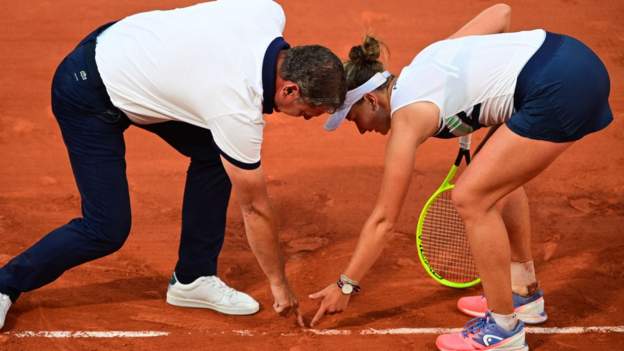
Seeing a chair umpire jump down to the court, scamper across the clay and point out the mark of a ball is one of the great traditions of the French Open.
The scene adds to the spectacle. A sense of anticipation hangs in the air, whistles or cheers from the Paris crowd - depending who the decision is for - accompany the official to the spot.
But, in a sport of high stakes and fine margins, is it time to stop relying solely on the human eye to decide crucial points?
At the recent Italian Open, Britain's Andy Murray was annoyed when a line call went against him because the umpire ruled the ball mark was on the line.
Murray strongly disagreed. Electronic line calling technology - not used at the Rome tournament but seen by television viewers - supported the former world number one's view.
The incident reignited a long-running debate whether an electronic system should be brought on to all courts - including Roland Garros' famous terracotta surfaces.
Is the technology unreliable on clay?
Unlike the other three Grand Slam tournaments, which are played on hard or grass courts, the French Open does not use the technology in any form.
The Australian Open and US Open - both played on hard courts - have already dispensed with human line judges in favour of solely relying on automated calls.
Wimbledon, played on grass, introduced Hawk-Eye technology in 2007 but the line judges remain. Players at the Championships are able to challenge calls up to three times per set.
The French Open continues to fully trust line judges and umpires, not allowing players to use electronic replays to challenge human decision.
For a long time it has been felt the red brick dust - a top layer of one to two millimetres - compromises the accuracy and reliability of an electronic system because it is a 'live' surface which moves during the match.
That has led to continuing issues of confidence from players, commentators and fans.
But Foxtenn - one of three systems used to judge line calls in tennis, alongside Hawk-Eye and IMG Arena - insists it is reliable.
Foxtenn is the only vendor which has so far operated an electronic line calling system on clay courts.
It says its 'real bounce technology' - which uses ultra-high-speed cameras capable of generating more than 100,000 images per second in combination with a laser scanner system - is suitable for the surface.
"It delivers perfect and constant real-time calibration," say the Barcelona-based company.
"It basically catches everything that happens on the court; anywhere from minute detail to every unthinkable angle."
Why doesn't the French Open use it?
Last month, the ATP Tour - the top tier of men's events - announced line judges will be replaced by an electronic calling system on all surfaces on a full-time basis from 2025.
The WTA, the governing body of women's tennis, told BBC Sport it has "been reviewing" going full-time with electronic line calling and is "very interested" in making a similar move to the ATP.
Remy Azemar, the French Open's head of referees, acknowledges the technology has been successful at other tournaments.
Yet the resistance remains firm.
Two factors fuel the French Open's reluctance to change: maintaining traditions synonymous with the 100-year-old tournament and an unwillingness to cede human control.
"Without the presence of the line judge, it is indeed very robotic," said Azemar. "But we must also recognise that it works.
"Will it make the game look a bit colder and emptier on the court? Everyone can have an opinion on that, it's not for me to answer."
France is widely considered one of the strongest nations when it comes to developing officials and Azemar says Roland Garros has "nothing to prove" in terms of its quality of officiating.
"As long as the human referee remains in charge, we are a little less directly concerned. We keep the freedom to make our decisions," he said.
Will we ever see it at Roland Garros?
With an increasing number of tournaments relying on electronic line calling, the French Open is fast becoming an outlier by sticking with tradition.
Foxtenn and Hawk-Eye have already been approved as a review system on clay with line judges, with Foxtenn being used at ATP events in Barcelona, Estoril, Madrid and Bastad last year.
No vendor has yet been approved to make sole decisions without the officials. Final testing of the automatic technology on clay is continuing.
The ATP, the men's governing body, said its impending move will "optimise accuracy and consistency across tournaments, match courts and surfaces".
Last season, there were 30 WTA events which used electronic line calling - including 13 that did not have line umpires.
Only two WTA clay-court events - Madrid and Iasi - used an electronic line calling review system in 2022.
With an even heavier reliance on the technology on the horizon, Azemar conceded the French Open could be forced into change.
"If 98% or 99% of the tournaments in the season are played without line judges, we will be backed into a corner," he said.
"I think we have to weigh things up carefully and give ourselves time. But we can also be caught up by reality."
What disputes have there been recently?
Disputes over line calls are regular occurrences during the European clay-court season and there were a number of notable examples during the recent Italian Open.
Murray's disagreement with Mohamed Lahyani in Rome blew up because of the three-time major champion's huge profile - and his heated reaction.
Lahyani was also involved in another similar incident in Rome. The Swedish umpire made a decision that left Danish player Holger Rune furious in a quarter-final against Novak Djokovic, which he eventually won.
Rune questioned whether officials were punished for "mistakes", as did Russia's Veronika Kudermetova who remonstrated with the chair umpire in her quarter-final.
At the French Open, there was a high-profile incident in 2021 that could have had even more damaging consequences.
In a dramatic semi-final against Greece's Maria Sakkari, Czech player Barbora Krejcikova was denied victory when chair umpire Pierre Bacchi overruled a call from a line judge on match point.
Television replays indicated the ball was out, leading Murray - watching on the television - to say Bacchi had made an "absolutely brutal error".
Krejcikova brushed off the disappointment, took another match point and won her maiden Grand Slam singles title two days later.
These disputes illustrate the confusion which still remains around clay-court marks. Whether the wrong mark has been checked, or the mark is not a true representation because of physics, tension can be created as a result.
"I don't mind that it's like this with line umpires judging," said Rune. "But it's about how you read the mark. Sometimes it is wrong."
Until the governing bodies are satisfied the technology is more accurate than the human eye, the drama over disputes will continue - perhaps over the next weeks at Roland Garros.
PSA players welcome chance to receive ‘the recognition we deserve’
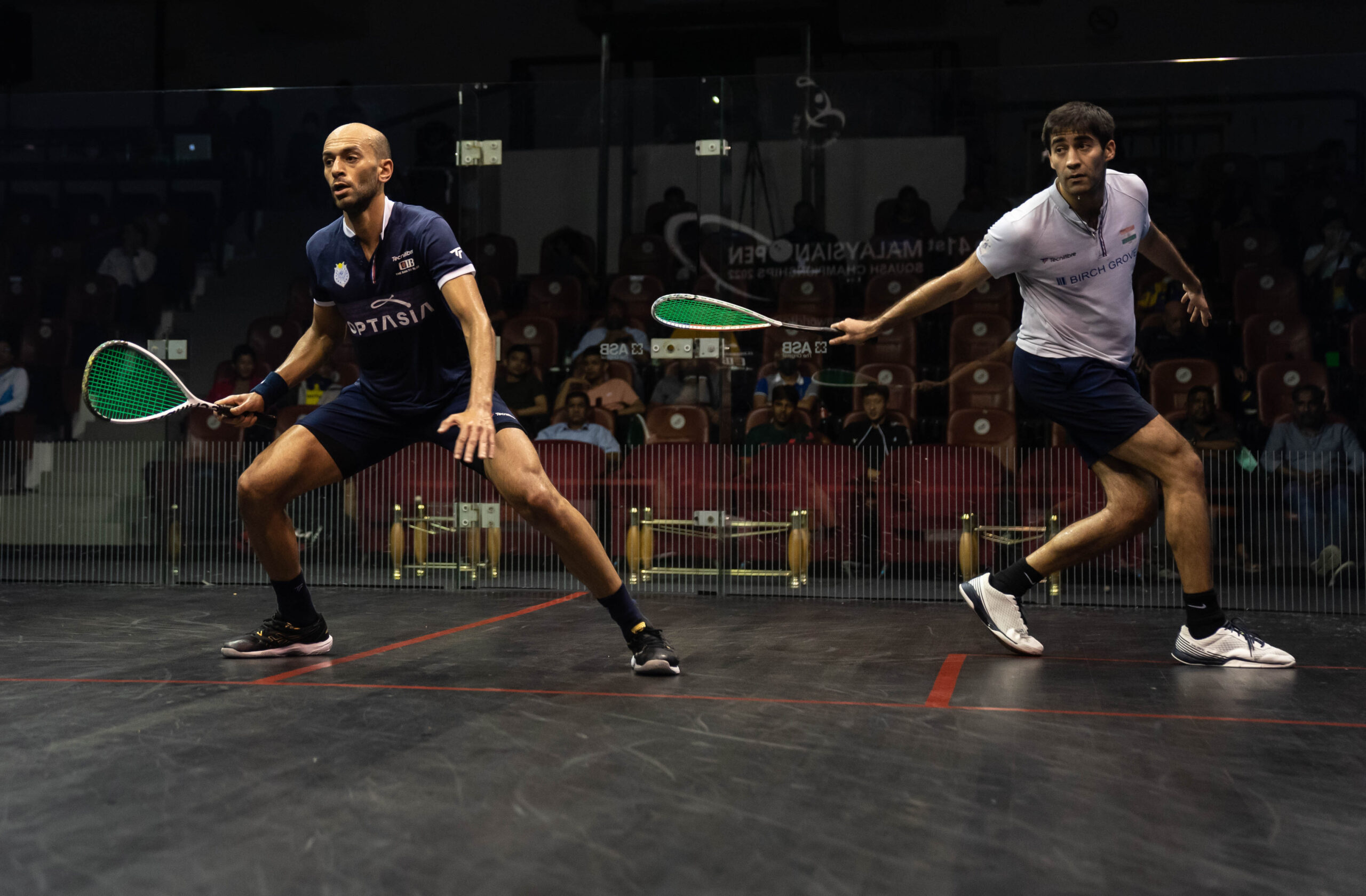
PSA World Tour players have united in their praise and gratitude after billionaire businessman Mark Walter’s “game changing” investment into professional squash.
Walter, who is co-owner of Chelsea FC and the LA Dodgers, has acquired a stake in Squash Media and Marketing (SMM), the commercial arm of the PSA.
The additional funding will be used to increase marketing of the sport and the PSA’s athletes, develop new digital products and services for squash fans worldwide and ramp up the creation and distribution of engaging content.
Walter, who’s already a squash benefactor after bankrolling the last three World Championships in Chicago and the Windy City Open since 2015, said he wants to make squash “a broader and more inclusive sport and to bring it to more fans.”
That is music to the ears of current players, particularly those outside the top 10 for whom the financial rewards of being a touring professional are currently modest.
As a former Wall Street banker, India’s world No.37 Ramit Tandon has greater insights into the world of investment than most squash players.
He told Squash Mad: “This is a big step for the PSA to have someone with his [Walter’s] expertise and resources on board and it’s something I believe the Tour needs. With this I see a lot more merger opportunities, sponsors and investors coming to the table.
“It’s also an achievement for the PSA and the players to be valued highly and get the recognition we feel we deserve.
“As an entity with Mark coming on board I definitely feel we have raised our value and I’m sure this will push our sport in the right direction from a financial and marketing standpoint.”
England’s world No.7 and Commonwealth Games women’s singles gold medallist, Gina Kennedy, echoed Tandon’s positive vibes.
“I think the new investment is absolutely amazing news,” the 26-year-old told us. “I am really excited to see the impact that it will have on the tour next season.
“I feel very fortunate to be an active PSA member at this exciting time and I have to applaud the PSA for securing this deal.
“The pro players will clearly benefit from seeing an increased amount of prize money and number of tournaments, which is a huge step for us as professional athletes. Hopefully the investment can help increase the popularity of the sport too.”
USA No.1 Amanda Sobhy tweeted: “Fantastic news for the sport and PSA World Tour! The Walter family have always been so supportive with the Windy City Open and World Champs, so it’s great to see him investing in Squash media & Marketing to help elevate our sport even more! Good things to come!”
France’s Victor Crouin had his say:
This is great news for our sport! Looking forward to seeing first-hand the impact this investment will have on the PSA Tour over the next few years ? https://t.co/wCBd9ieFHP
— Victor CROUIN (@VCrouin) May 23, 2023
And Egypt’s Marwan ElShorbagy commented: “Thanks to the Walter family for the continued support to our sport [and] all credit to the PSA World Tour for getting this deal done!”
Newcastle Falcons: Gary Graham & Micky Young among 15 players departing
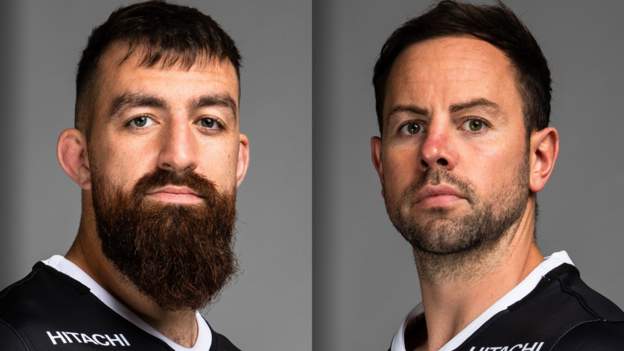
Scotland back-rower Gary Graham, scrum-half Micky Young, lock Greg Peterson and prop Logovi'i Mulipola are among 15 players to leave Newcastle Falcons.
Young, 34, racked up 200 appearances for the Falcons, and will now retire.
Graham, 30, played 95 games and attracted England attention before switching allegiance to Scotland.
United States international Peterson, 32, featured 75 times, while Samoa's Mulipola, 36, played 79 matches across his five seasons at Kingston Park.
Homegrown lock Sean Robinson, after 135 games for the club, will also be leaving, as will former Sale and Bath back-rower Carl Fearns after two years at Kingston Park.
Full-back Alex Tait and back-rower Will Welch had already confirmed their retirements.
Conrad Cade, Connor Collett, Matthew Dalton, Conor Kenny, Pete Lucock, Tom Marshall and Cameron Nordli-Kelemeti complete the list of departures.
Alun Wyn Jones: Wales legend to captain Barbarians after announcing international retirement
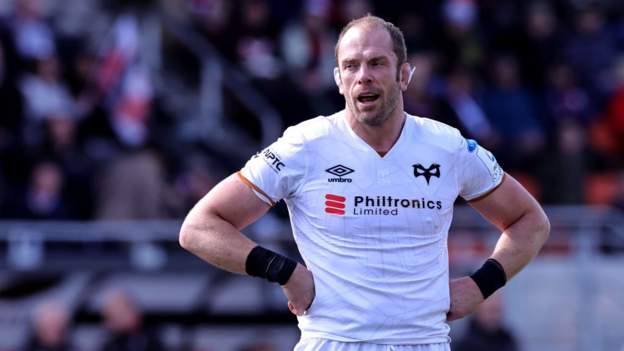
Alun Wyn Jones will captain the Barbarians against the World XV at Twickenham after announcing his international retirement.
Israel Folau starts on the wing for the World XV, who are skippered by Italy's Michele Lamaro.
Steve Hansen is coaching the World XV while ex-England coach Eddie Jones takes charge of the Barbarians.
It will be the first time Jones has returned to Twickenham since he was sacked in December.
The Rugby Football Union (RFU) will be flying a Pride flag at Twickenham this Sunday (14:00 BST) and Hansen has welcomed the decision, saying the stance is a "positive consequence" of Folau's selection.
Folau, 34, was sacked by Rugby Australia in 2019 for making anti-gay comments on social media.
The two teams are invitational, meaning the coaches select players from any country to participate. The game is not a Test match as, while it is played at Test level, no caps are awarded.
In a statement released on Wednesday, the RFU said it "supports the LGBTQ+ community" and understands if they "feel unwelcome" and "disheartened by the appeared acceptance of anti-LGBTQ+ viewpoints on the pitch".
It said the RFU is "challenging, and will continue to challenge, exclusionary behaviour and micro aggressions to ensure everyone feels respected, empowered and accountable".
Team line-ups
Barbarians: Anscombe; Radwan, Tamanivalu, Kerevi, Li; Cooper, Maunder; Waller, Dolly, Pieretto, AW Jones (captain), Lewies, Wainwright, Yamamoto, Luatua.
Replacements: Thacker, West, Sadie, Simmons, Vailanu, Hougaard, Cruden, Johnson.
World XV: Piutau; Folau, Radradra, Laumape, Nkosi; Hastings, Phipps; W Jones, Brown, Kebble, Ratuniyarawa, Hockings, Negri, Lamaro (captain), Mata.
Replacements: Dee, Dell, Street, N Cannone, Murphy, Hall, Patchell, Rasaku.
United Rugby Championship exploring draft system to improve competition
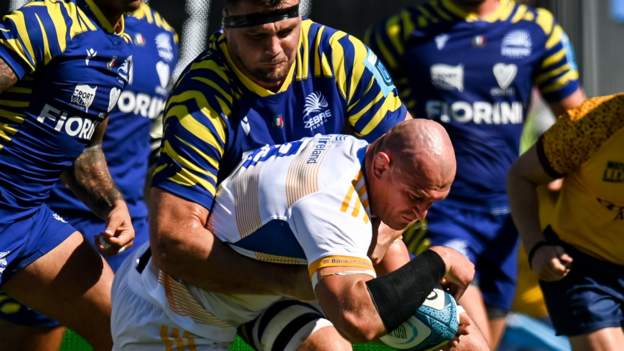
The United Rugby Championship is exploring a form of draft system to improve competitiveness across the league.
Italian side Zebre lost all 18 games this season as they finished bottom of the table in consecutive seasons.
Leinster topped the table after the regular season and only lost twice - including the semi-final to Munster.
Chief executive Martin Anayi says the URC needs to "think laterally" about improving the weaker teams' standards.
"There might be an ability to draft in players from the other unions who aren't getting game time," he told BBC 5 Live. "That is 100% [a conversation]."
One of the biggest defeats Zebre suffered this season came at the hands of the Bulls, who beat them 78-12. The Dragons, who finished second from bottom, only managed to win four games from 18.
Anayi says a lack of jeopardy at the bottom of the table is a result of a "closed league", one without promotion and relegation.
"There is a natural filter system to relegation, one team goes down and the team that comes up is full of expectation because they have won the league below; we don't have that in a closed league," he added.
"Our job is to find ways of helping the likes of Zebre and the Italian Federation to make them more competitive.
"In American sports they have a system for doing that, the draft system. We don't have that, so we need to think a bit more laterally about that question.
"Ireland have so much talent they are trying to work out how does everybody get game-time, while Scotland have two teams so that creates a bottleneck for them.
"So those are avenues we are trying to explore. We are setting up a high-performance think-tank to help us with that question, from a league-wide point of view.
"Zebre has been at the bottom of our table for a wee while and we need to try and do something to help them."
Anayi says there is enough collaboration to ensure a draft system could work, without concerns from other unions about improving rival teams.
"We have that collaboration at union level. They see the league is better and more commercially viable if all the teams are competitive," he added.
"And secondly they want the Six Nations to be competitive. Our unions can see that helping Zebre is a good thing both for the league and also for the Six Nations."
'League needs different winners'
Leinster have dominated the league in recent years, winning four titles in row between 2018 and 2021, but that monopoly has been broken over the past two seasons.
While the Dublin-based team only lost once in the regular campaign, they were beaten in the semi-final by Munster, a year on from losing a last-four meeting against Bulls.
"They have been beaten twice in play-off format in the URC, and that's what we need, not for Leinster to be beaten, but to have jeopardy," Anayi added.
"We are going to have a team that isn't Leinster winning it [for the last] two years, after they won the previous four.
"I think it's good to see a different name on the trophy each year."
Stormers host Munster in this year's showpiece, in front of a sell-out crowd in Cape Town, with Anayi praising the impact of the South African franchises on and off the field.
"They have just been great for the tournament," he said.
"And it's built in South Africa too. [At first] they didn't know what URC was, they didn't know what the Champions Cup or the Challenge Cup was, but we've seen the Stormers build from 20,000 [attendances], to 30,000, through 40,000 and now we have got our first sell-out of 57,000.
"It's been an amazing couple of years."













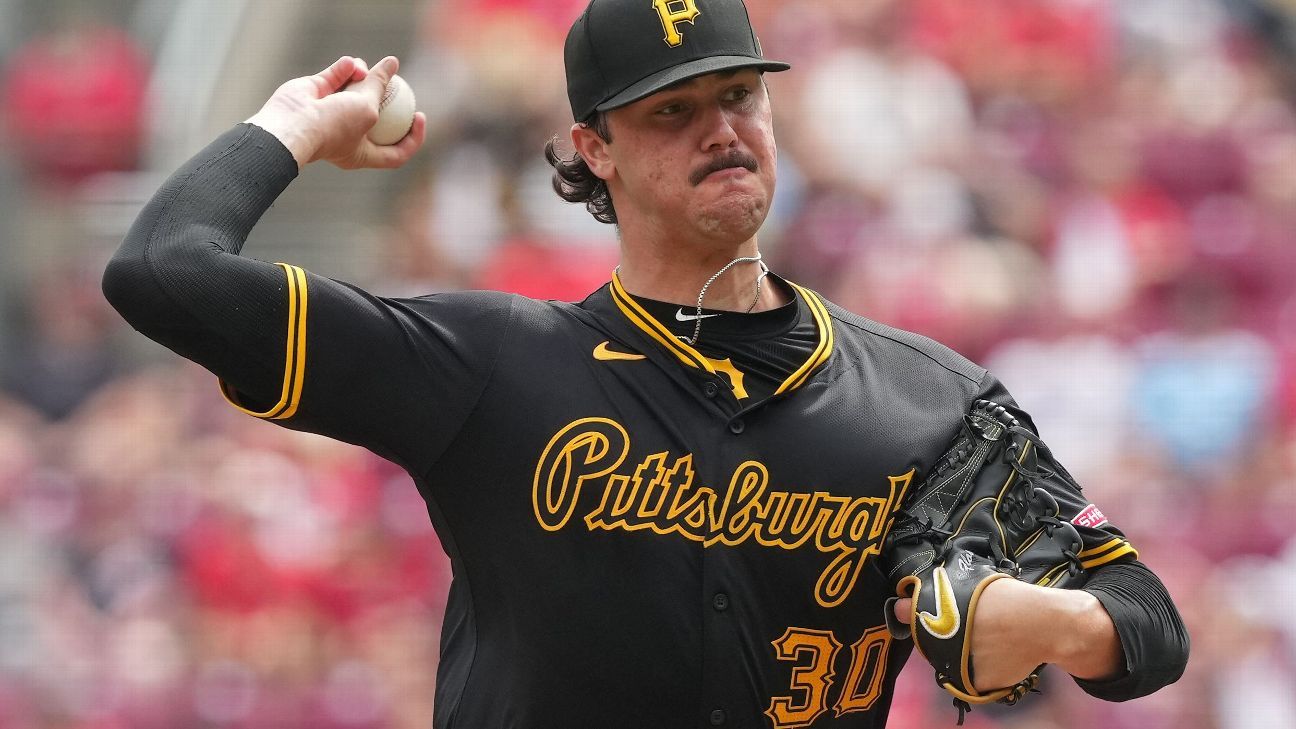

 Phone: (800) 737. 6040
Phone: (800) 737. 6040 Fax: (800) 825 5558
Fax: (800) 825 5558 Website:
Website:  Email:
Email: 






